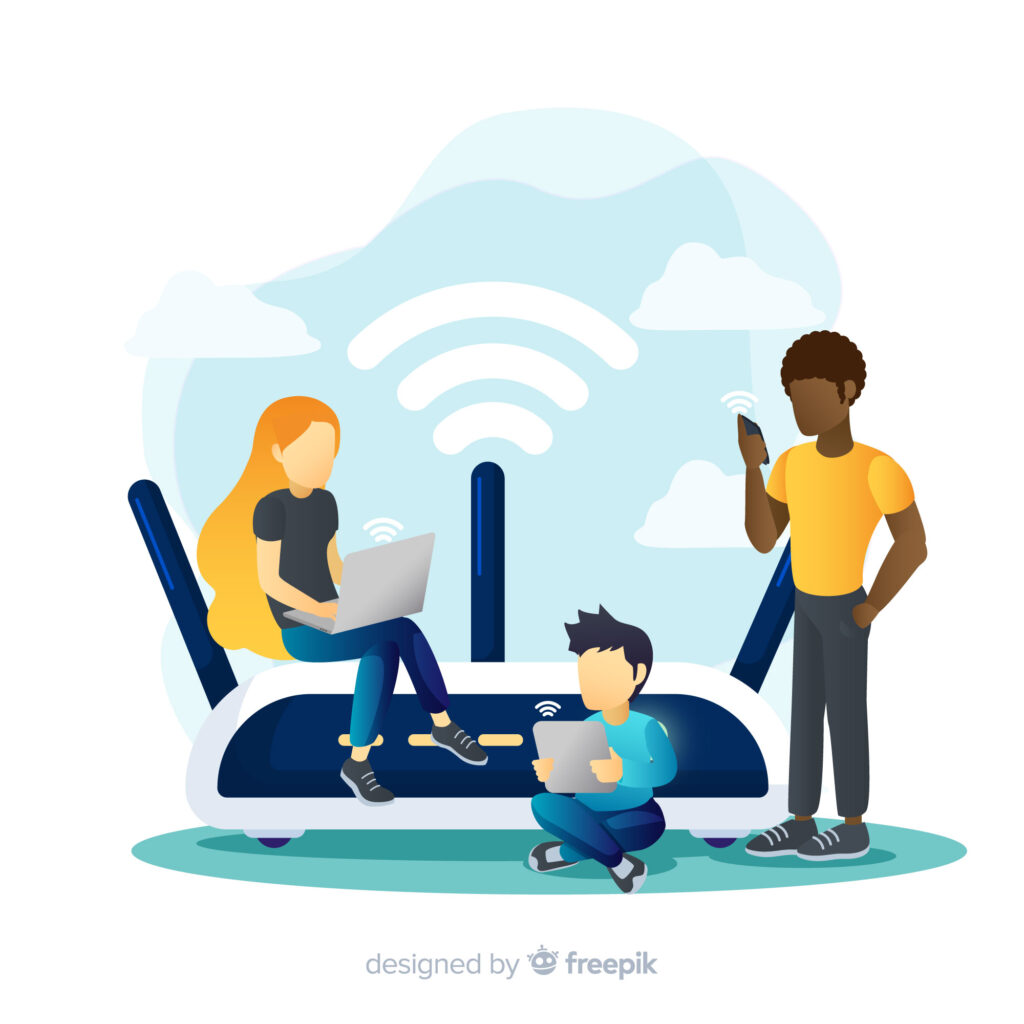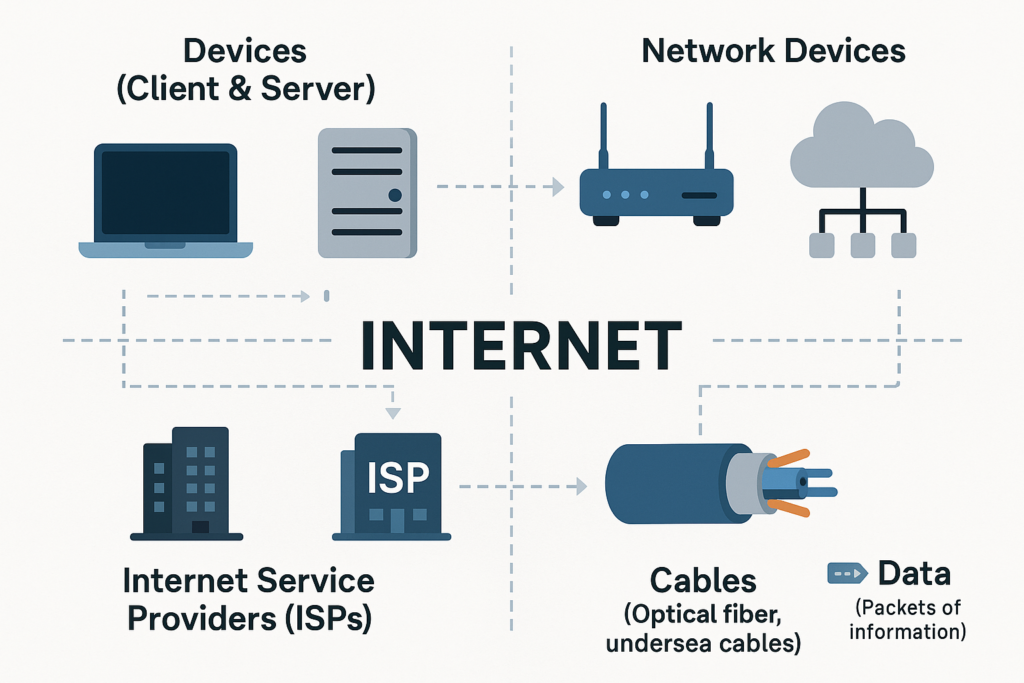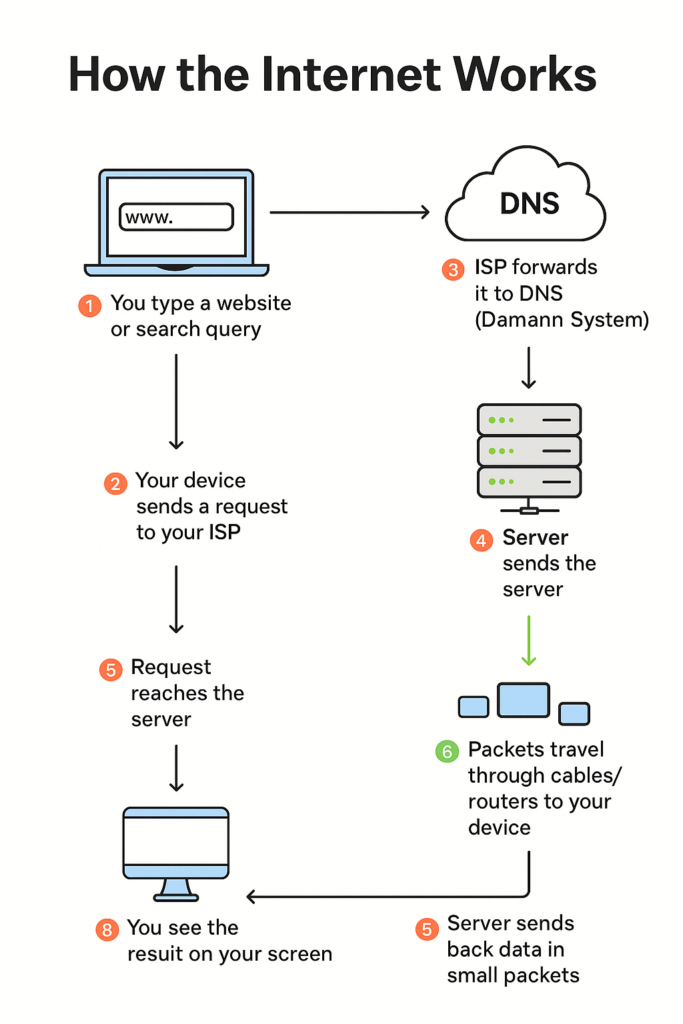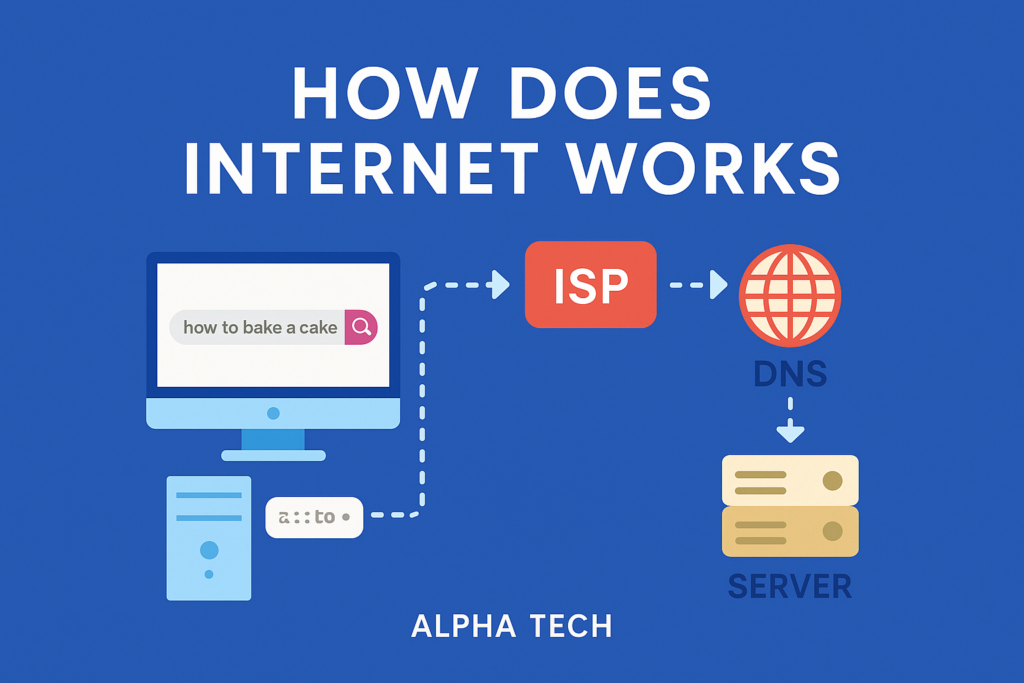Introduction:
Do you know ? What is the Internet & How Does internet Works? The internet is something we all use every day—whether it’s to watch YouTube videos, chat with friends, or search for answers on Google. But have you ever stopped to wonder how it actually works?
The internet is like a giant invisible web that connects computers and devices all around the world, letting them share information with each other in seconds. In this blog, we’ll break down the process in a super simple way so that even if you’re not tech-savvy, you’ll finally understand how the internet really works.
Why it’s important to understand how it works
Most of us use the internet every single day, but we don’t always think about what’s happening behind the scenes. Understanding how the internet works helps you become more aware of what’s going on when you open a website, click a link, or send a message.
It’s like knowing how a car works—you don’t have to be a mechanic, but a basic idea makes you a smarter and safer user. Plus, if you’re a student or planning a tech career, this knowledge gives you a strong foundation for learning more advanced topics later.
In this blog post, you’ll learn how the internet works in a simple, easy-to-understand way—perfect for students and beginners.
Go to here for deeper understanding–

Link: https://developer.mozilla.org/en-US/docs/Learn/Common_questions/How_does_the_Internet_work
2. What is the Internet?
The internet, sometimes simply called the net, is a worldwide system of interconnected computer networks and electronic devices that communicate with each other using an established set of protocols.
The internet is a global network that connects millions of computers and devices, allowing them to share information with each other. It’s what makes it possible to browse websites, watch videos, send emails, and chat with people anywhere in the world—all in just a few seconds.
To understand how the internet works, just think about the apps and websites you use every day.
let’s understand with examples-
When you search something on Google, your device connects to Google’s servers through the internet to get your answer.
When you watch a video on YouTube, the video is stored on YouTube’s servers and is sent to your phone or computer through the internet in the form of data.
When you send a message on WhatsApp, it travels through the internet to reach your friend’s phone—no matter where they are in the world.
All these activities are only possible because the internet acts like a super-fast delivery system for data between devices.
Many people think of the internet as one big machine or a central system—but that’s not true. The internet is actually a huge network of millions of smaller networks that are all connected together. It’s made up of computers, servers, cables, satellites, and more, all working together to share information. No single person or company owns the entire internet—it’s a global system that connects devices from all over the world.

3.Main Components of the Internet

The internet is a powerful system that connects billions of devices across the globe. But how does it really work? It’s all made possible through several key components working together behind the scenes. Here’s a breakdown of the most common components of the internet:
1. Devices (Client & Server)
- Client Devices are the tools we use to access the internet — such as smartphones, laptops, desktops, or tablets. These devices request information from the internet, like loading a website or streaming a video.
- Servers are powerful machines that store and manage web content, applications, and data. They respond to client requests by delivering the required information.
Example: When you type a website URL into your browser, your device sends a request to the server, which responds by displaying the web page.
2. Network Devices
Network devices are the hardware that help direct and manage data traffic across networks.
- Routers forward data between networks and direct traffic on the internet.
- Modems connect your home or business to your Internet Service Provider (ISP).
- Switches are mainly used in local networks to manage the flow of data between devices.
These devices work together to ensure that data is trans
3. Internet Service Providers (ISPs)
ISPs are companies that provide individuals and organizations with access to the internet. Examples include companies like Jio, Airtel, and BSNL. ISPs connect your device to the broader internet and may also offer services like domain registration, hosting, and technical support.
Without an ISP, it would be impossible for most users to access the internet.
4. Cables (Optical Fiber & Undersea Cables)
Even though we often associate the internet with wireless technology, most internet traffic still travels through physical cables.
- Optical Fiber Cables use light signals to transmit data at high speeds over long distances. They are commonly used by ISPs and data centers.
- Undersea Cables are laid on the ocean floor and connect different continents, enabling international internet communication.
More than 99% of global data transfers, including emails, websites, and videos, depend on these undersea cables.
5. Data (Packets of Information)
Every file, message, or webpage sent over the internet is broken into smaller units called data packets. These packets travel separately through the network and are reassembled at their destination.
This method increases reliability and efficiency, ensuring that even if one path is congested, packets can take alternate routes to reach the user.
6. DNS (Domain Name System)
What it is:
DNS is like the phonebook of the internet. It translates website names (like google.com) into IP addresses (like 142.250.190.78).
Why it’s important:
It helps your browser find the correct server when you type a website name.
How Does Internet Works? (Step-by-Step Explanation)

Let’s understand how the internet works by using something familiar—searching on Google.
Think of it like asking a friend for help finding something. Here’s what happens step by step:
Step 1: You type a website or search query
You open your browser and type something like “how to bake a cake” on Google.
This is your request. Your device is now ready to ask the internet for information.
Step 2: Your device sends a request to your ISP
Once you hit enter, your device sends this request to your Internet Service Provider (ISP)—such as Jio, Airtel, or BSNL.
The ISP works like a courier service that takes your request and forwards it to the right place.
Step 3: ISP forwards it to DNS (Domain Name System)
Now the ISP checks with the DNS, which acts like the internet’s contact list.
You typed “google.com”, but computers need an exact address called an IP address.
The DNS finds the IP address linked to that website name.
Step 4: DNS finds the website’s IP address
The DNS quickly responds with something like:
“google.com is located at 142.250.190.78.”
Now your device knows exactly where to send your search request.
Step 5: Request reaches the server
Using the IP address, your request reaches Google’s server—a powerful computer that stores all the search data.
The server reads your query and prepares the results for you.
Step 6: Server sends back data in small packets
The server doesn’t send all the data in one big file. It breaks it into small pieces called data packets.
These packets are easier and faster to send over the internet.
Step 7: Packets travel through cables, routers, and switches
The data packets travel through underground cables, routers, and network switches to reach your device.
It’s like many delivery vehicles carrying small parts of a package on different routes.
Step 8: Your device receives the data and shows it on screen
Your device receives all the packets and puts them together like pieces of a puzzle.
Once everything is received, your screen displays the search results.
And that’s how the internet works—fast, silent, and behind the scenes. All of this happens in just a few seconds while you simply wait for your search to load.
IP Address
An IP address (Internet Protocol address) is a unique number assigned to every device or website on the internet. It works like a home address, helping data find the right destination.
DNS (Domain Name System)
The DNS is like the phonebook of the internet. It converts website names (like google.com) into IP addresses that computers understa
Server
A server is a powerful computer that stores websites, apps, and data. When you visit a site, the server sends the required information to your device.
Client
A client is any device (like your phone, laptop, or tablet) that sends requests to servers to get data—like when you open a webpage or app.
Data Packet
A data packet is a small piece of data that is sent over the internet. Big files are broken into many packets, sent separately, and reassembled by your device.
5.Conclusion:
The internet may seem complex, but at its core, it’s just a smart system that allows devices to talk to each other and share information. From typing a search query to seeing results on your screen, everything follows a simple step-by-step process involving clients, servers, DNS, IP addresses, and data packets.
The amazing part is—you use this process every single day without even realizing it, whether you’re browsing, chatting, or watching videos. Understanding how it works is just the beginning.
As a student in the digital age, take this as a motivation to explore more about how technology shapes our world—you’ll be surprised how much there is to learn.
you can read the further information on my blog posts
How does internet works, How does internet works, How does internet works, How does internet works, How does internet works, How does internet works, How does internet works, How does internet works, How does internet works, How does internet works, How does internet works, How does internet works, How does internet works, How does internet works, How does internet works, How does internet works, How does internet works, How does internet works, How does internet works, How does internet works, How does internet works, How does internet works, How does internet works, How does internet works, How does internet works, How does internet works, How does internet works,



